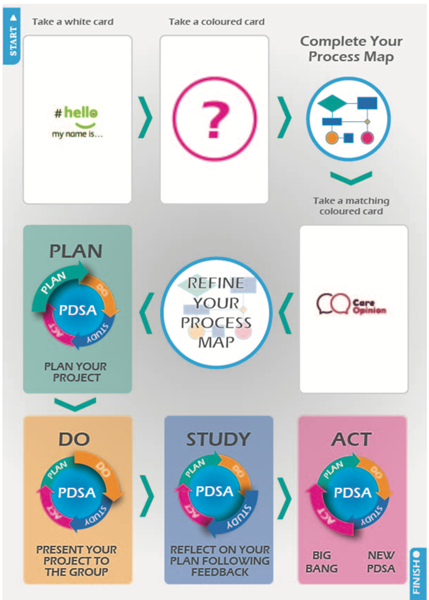This is a guest blog post from Lucy Kirkham, Senior Lecturer in Adult Nursing and IPE Lead for Nursing and Midwifery, Sheffield Hallam University.
I am a senior lecturer in adult nursing at Sheffield Hallam University and nursing lead for Interprofessional Education (IPE), where a diverse range of professions learn with, from and about each other to build collaborative practice and improve patient experience.
The final part of this focuses on service improvement. We teach our students about how to lead service improvement with the patient at the centre. We encourage them to consider the principles of co-production, where people who use services, their families or carers and the care providers work together to develop a service which works best for everyone.
We also introduce them to tools and techniques which will help in planning, implementating and reviewing their idea. Students are expected to develop their own service improvement idea as part of their assessment, to prepare them for leading change in practice.
Why did we decide to develop a game?
Our module runs twice a year and I always evaluate my module formally and informally to see how we can improve things. This year I set up an online page where students could feedback on their experience as soon as teaching was finished. Feedback was very positive, but it was clear there was an issue with consistency: not everyone was receiving the same activities. And not everyone could see the rationale for the activities or how they linked to practice.
Staff feedback confirmed this: they didn’t enjoy facilitating the last activity and sometimes found an alternative or just discussed the principles. It was clear we needed to find a new activity which was interprofessional, fun, relevant to clinical practice, made the assignment brief clearer, was easier for facilitators to deliver and was more environmentally friendly as we were currently wasting lots of paper! A tall order, to say the least.
How we went about it
If we were teaching students to co-produce improvement work with the people who would be using services, then we should follow the same principles. So I enlisted the help of several enthusiastic colleagues along with Co:Create, the coproduction team at South Yorkshire Housing Association (link). I spoke with staff at local hospitals and the team at Fab Change Week (link) and researched what was already out there. We had a workshop with Co:Create to brainstorm what we needed, what we wanted, what students needed and wanted and what our stakeholders (employers and service users) needed and wanted.
I used an online survey to ask our students more about what they needed and invite them to a focus group. We refined our ideas for a game and developed a prototype. Co:Create facilitated the focus group. We had to consider logistics such as the cost of the 200 copies we would need and the simplicity of the instructions to ensure students all received the same experience.
We decided to develop a video to introduce the activity to ensure we highlighted key points such as the relevance to practice and the importance of keeping the patient at the centre of the service improvement. I liaised with our faculty technical team to develop our game and the printed cards ready to use in IPE week.
The game we created
We have developed a game which uses “hello, my name is…” to introduce a patient to the group. This was a service improvement developed by Kate Granger, a doctor with cancer who recognised that care is often very impersonal and we don’t always introduce ourselves. This means the game is different every time it is played, depending on the card selected.
Students select a card explaining the scenario. They are asked to draw a process map looking at the patient journey. Then they pick a further card: the “Care Opinion” card! This provides them with service user feedback explaining the patient’s perspective and their experience, which helps them to develop their process map from a co-production perspective and go on to develop their service improvement as they progress through the game.
Every time the game is played it will be a different patient in a different location with a different experience… so the service improvement possibilities are endless. We will be delivering this activity at the start of the new curriculum, so we’ll let you know how it goes. And, of course, we’ll be collecting feedback from students and staff, to help us improve it.
Learning about service improvement: our new board game
Learning about service improvement: our new board game https://www.careopinion.org.uk/resources/blog-resources/1-images/101983a55157423ebe9ef50cc0fefb0a.jpg Care Opinion 0114 281 6256 https://www.careopinion.org.uk /content/uk/logos/co-header-logo-2020-default.pngUpdate from Care Opinion
Posted by Care Opinion, on
Response from HysteroscopyAction on 12 Aug 2018 at 13:48
Am writing on behalf of the Campaign Against Painful Hysteroscopy. That's such an impressive game you've created using feedback from 'real' patients. Your hospital has a great reputation. Many of your students will go on to work at other hospitals.
It would be wonderful if your teaching could empower nurses, and other hcps, to be bold enough to intervene to stop an outpatient procedure when a patient is clearly in severe distress or severe pain. Sadly, our campaign hears stories from hospitals all over the country where patients are screaming or crying during outpatient hysteroscopy and the team doesn't stop. The resulting PTSD and subsequent lack of trust in the NHS which the patient suffers is awful. Would be great if you could tweak the 'game' to demonstrate instances when the nurse needs to be a patient's advocate and stand up to the consultant. Thanks!
Response from Sheffnurse on 17 Aug 2018 at 14:04
Thank you for your feedback! I'm so sorry to hear about the experiences you are describing. We have actually included a patient who is in hospital where options include service improvements around privacy and dignity, a lack of information and failure to introduce self, and a scenario around poor pain management that good unrecognised. This will enable us to discuss the above issues with our learners, who are all future health and social care practitioners such as nurses, physios, radiographers and so on. We can then frame this around person centred care, coproduction of services and being an advocate for the patient. Thank you so much.


